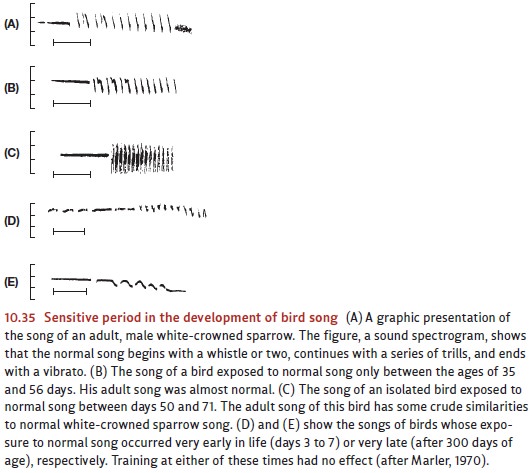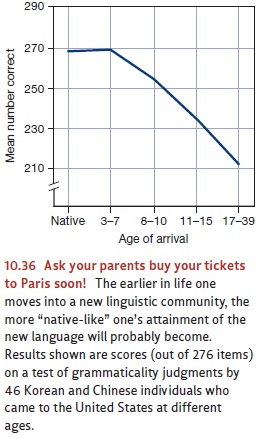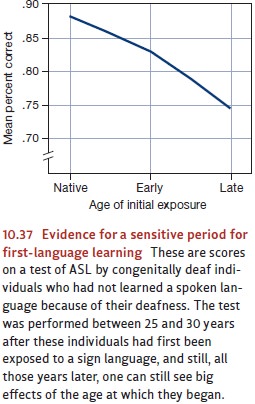Chapter: Psychology: Language
The Sensitive Period Hypothesis
The Sensitive
Period Hypothesis
The human brain continues to grow
and develop in the years after birth, reaching its mature state more or less at
the age of puberty, with some further brain development— especially in the
prefrontal cortex—continuing well into adolescence. If language is indeed
rooted in brain function, then we might expect language learning to be
influenced by these maturational changes. Is it? According to the sensitive period hypothesis, the brain
of the young child is particularly well suited to the task of language
learning. As the brain matures, learning (both of a first language and of later
languages) becomes more difficult (Lenneberg, 1967; Newport, 1990).
Sensitive periods for the uptake
and consolidation of new information seem to govern some aspects of learning in
many species. One example is the attachment of the

young of various animals to their mothers, which generally can be formed only in early childhood . Another example is bird song. Male birds of many species have a song that is characteristic of their own kind. They learn this song by listening to adult males of their species. But this exposure will be effective primarily when it occurs at a certain period in the bird’s life. To take a concrete case, baby white-crowned spar-rows will learn their species song in all its glory, complete with trills and grace notes, only if they hear this music (sung, of course, by an adult white-crowned sparrow) some-time between the 7th and 60th day of their life. If they do not hear the song during this period, but instead hear it sometime during the next month, they acquire only the rudi-ments of the song, without the full elaborations heard in normal adults (Figure 10.35).
If the exposure comes still
later, it has almost no effect. The bird will never sing nor-mally (Marler,
1970).
Do human languages work in the
same way? Are adults less able to learn language because they have passed
beyond some sensitive learning period? Much of the evidence has traditionally
come from studies of second-language learning.
SECOND – LANGUAGE LEARNING
In the initial stages of learning
a second language, adults appear to be much more effi-cient than children (Snow
& Hoefnagel-Hohle, 1978). The adult will venture halting but comprehensible
sentences soon after arrival in the new language community while the 2-year-old
may at first lapse into silence. But in the long run the outcome is just the
reverse. After a few years, very small children speak the new language fluently
and soon sound just like natives. This is much less common in adults. This
point has been docu-mented in many studies. In one investigation, the participants
in the experiments were native Chinese and Korean speakers who came to the
United States (and became immersed in the English-language community) at
varying ages. These individuals were tested only after they had been in the
United States for at least 5 years, so they had had ample exposure to English.
And all of them were students and faculty members at a large midwestern
university, so they shared some social background (and presumably were
motivated to learn the new language so as to succeed in their university
roles).
In the test procedure, half of
the sentences the participants heard were grossly ungrammatical (e.g., The farmer bought two pig at the market; The
little boy is speak to apoliceman). The other half were the grammatical
counterparts of these same sentences.The participants’ task was to indicate
which sentences were grammatical in English and which were not. The results are
shown in Figure 10.36. Those who had been exposed to English before age seven
performed just like native speakers of English. Thereafter there was an
increasing decrement in performance as a function of age at first exposure. The
older the subjects when they first came to the United States, the less well
they acquired English (J. Johnson & Newport, 1989).

Recent experimentation confirms
that very young children acquire second languages at native levels, and adds
important detail about this process. Snedeker, Geren, and Shafto (2007)
followed the language learning progress of Chinese children adopted (at ages 2
to 6 years) by Americans. After adoption, these children were immersed in
monolingual English-language environments. Their English-language learning was
compared with that of American-born infants. Would the older Chinese-born
children learn differently (because they were more cognitively mature)? Or
would they learn in the same way as the infants (because all of them were
learning English from scratch)? The results show both effects: Just like infant
first-language learners, the adoptees learned nouns before verbs, and content
words before function words, suggesting that such words are easiest to learn
regardless of cognitive status of the learner. But the adoptees acquired
vocabulary at a faster rate, and so caught up to native-born age-mates after 18
months or so of being in the new language community Finally, we can ask how the
native and later-learned languages are distributed in the brain. It could be,
for example, that the usual brain locus for language gets set up pre-cisely in
the course of acquiring a first language and thereafter loses plasticity; as a
result, the later-learned language must be shunted into new areas that are not
special-ized for, or are secondary for, language. This would be another way of
explaining why knowledge of the first language is generally so much better than
knowledge of the sec-ond or third or fourth language learned. There is in fact
accumulating evidence that the brain loci of late-learned languages usually are
different from those of the first-learnedIf the exposure comes still later, it
has almost no effect. The bird will never sing nor-mally (Marler, 1970).
Do human languages work in the
same way? Are adults less able to learn language because they have passed
beyond some sensitive learning period? Much of the evidence has traditionally
come from studies of second-language learning.
SECOND - LANGU AGE LEARNING
In the initial stages of learning
a second language, adults appear to be much more effi-cient than children (Snow
& Hoefnagel-Hohle, 1978). The adult will venture halting but comprehensible
sentences soon after arrival in the new language community while the 2-year-old
may at first lapse into silence. But in the long run the outcome is just the
reverse. After a few years, very small children speak the new language fluently
and soon sound just like natives. This is much less common in adults. This
point has been docu-mented in many studies. In one investigation, the
participants in the experiments were native Chinese and Korean speakers who
came to the United States (and became immersed in the English-language
community) at varying ages. These individuals were tested only after they had
been in the United States for at least 5 years, so they had had ample exposure
to English. And all of them were students and faculty members at a large
midwestern university, so they shared some social background (and presumably
were motivated to learn the new language so as to succeed in their university
roles).
In the test procedure, half of
the sentences the participants heard were grossly ungrammatical (e.g., The farmer bought two pig at the market; The
little boy is speak to apoliceman). The other half were the grammatical
counterparts of these same sentences.The participants’ task was to indicate
which sentences were grammatical in English and which were not. The results are
shown in Figure 10.36. Those who had been exposed to English before age seven
performed just like native speakers of English. Thereafter there was an
increasing decrement in performance as a function of age at first exposure. The
older the subjects when they first came to the United States, the less well
they acquired English (J. Johnson & Newport, 1989).
Recent experimentation confirms
that very young children acquire second languages at native levels, and adds
important detail about this process. Snedeker, Geren, and Shafto (2007)
followed the language learning progress of Chinese children adopted (at ages 2
to 6 years) by Americans. After adoption, these children were immersed in
monolingual English-language environments. Their English-language learning was
compared with that of American-born infants. Would the older Chinese-born
children learn differently (because they were more cognitively mature)? Or
would they learn in the same way as the infants (because all of them were
learning English from scratch)? The results show both effects: Just like infant
first-language learners, the adoptees learned nouns before verbs, and content
words before function words, suggesting that such words are easiest to learn
regardless of cognitive status of the learner. But the adoptees acquired
vocabulary at a faster rate, and so caught up to native-born age-mates after 18
months or so of being in the new language community
Finally, we can ask how the native and later-learned languages are distributed in the brain. It could be, for example, that the usual brain locus for language gets set up pre-cisely in the course of acquiring a first language and thereafter loses plasticity; as a result, the later-learned language must be shunted into new areas that are not special-ized for, or are secondary for, language. This would be another way of explaining why knowledge of the first language is generally so much better than knowledge of the sec-ond or third or fourth language learned. There is in fact accumulating evidence that the brain loci of late-learned languages usually are different from those of the first-learned language, a finding consistent with this suggestion. However, there are other possible interpretations of the same finding. Possibly the real cause of different loci for the two languages is the individual’s differential proficiency rather than the fact that one was learned before the other. One group of investigators supported this view by studying rare examples of people who learn a language in adulthood and become whizzes at it. Not surprisingly, many of these high-proficiency subjects were college instructors in modern language departments. The finding was that brain activity for both their lan-guages occurred in the same brain sites (Perani et al., 1998).
LATE EXPOSURE TO A FIRST LANGUAGE
These second-language learning
results lend some credence to the sensitive period hypothesis which, as earlier
noted, is also consistent with the differential language recovery of isolated
children (the cases of “Isabel” and “Genie”). However, there is an alternative
explanation. Possibly, second languages are rarely as well learned as first
languages because language habits ingrained with the first language interfere
with learning the second one (Seidenberg & Zevin, 2006). To distinguish
between the sen-sitive period hypothesis and such interference accounts, it
would be helpful to find individuals who acquired their first language at different ages. The best line of evidence in this
regard comes from American Sign Language (ASL). As we discussed earlier, many
congenitally deaf children have hearing parents who choose not to allow their
offspring access to ASL. Such children’s first exposure to ASL, therefore, may
be quite late in life when they first establish contact with the deaf
community. Because their hearing deficit did not permit them to learn the
spoken language of their caretakers either, such individuals are learning a
first (signed) language at an unusually late point in maturational time.
How does this late start
influence language learning? In one study, all of the partic-ipants had used
ASL as their sole means of communication for at least 25 years, guar-anteeing
that they were as expert in the language as they would ever become. Some of
them had been exposed to ASL from birth (because their parents were deaf
signers). Others had learned ASL between the ages of 4 and 6 years. A third
group had first come into contact with ASL after the age of 12.
Not surprisingly, all of these
signers were quite fluent in ASL, thanks to 25-plus years of use. But even so,
the age at first exposure had a strong effect (Figure 10.37). Those who had
learned ASL from birth used and understood all of its elaborations. Those whose
first exposure had come after the age of 4 years showed subtle deficits. Those
whose exposure began in adolescence or adulthood had much greater deficits, and
their use of function items was sporadic, irregular, and often incorrect
(Newport, 1990, 1999).

Related Topics